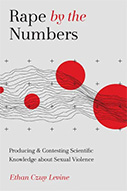Rape by the Numbers: Producing and Contesting Scientific Knowledge about Sexual Violence

Author: Ethan Czuy Levine
Publisher: Rutgers University Press, 2021. 244 pages.
Reviewer: Heather R. Hlavka | September 2022
Students likely come to criminology or gender violence courses with some understanding of the limitations of crime statistics (even if they do not know it yet), especially for rape and sexual assault. Perhaps they questioned the definition or meaning of rape, wondered if what they experienced was sexual assault, or why they and their friends never reported to police or other authorities. And most come to these courses reciting the popular statistic that “one in four women have experienced completed or attempted rape” in their lifetimes. Someone may have shared the statistic as an instructive warning prior to the first fall semester of college. It is likely that a friend, or two, were sexually assaulted sometime between the beginning of the fall semester and the mid-November break, during the period campus advocates call the “red zone.” But what does the “one in four” statistic mean and what did it do to the study of rape? Who is excluded from this statistic and what sorts of sexual scripts embody cautionary, traditional scenarios like those presented above? In Rape by the Numbers, Ethan Czuy Levine weaves a narrative of knowledge production and contestation on sexual violence, asking “who and what ‘counts,’ and how this varies” (pg. 3). Through an extensive content and textual analysis of scientists’ approaches to studying rape in the United States and Canada between 1975 and 2015, Levine demonstrates how science played a substantial role in shaping popular understandings of sexual violence. This entangled understanding is part epistemology and methodology, part power, and part politics – much of which is commonplace in science, yet also sensitively unique to a moralized and feminized field of study like sexual violence.
Levine investigates how scientists come to know the scope, causes, and effects of rape, as well as the social processes that shape and are shaped by scientific research. Using a mixed methods approach, he compiled a dataset of more than 1,300 studies of sexual violence among adults over four decades, and interviewed 31 scholars researching and publishing on sexual violence. Theoretically informed by feminist science studies literature on agential realism, situated knowledge, ontological gerrymandering and enactments, Levine asks how scientists have conceptualized sexual violence among adults, and what social mechanisms have enabled, constrained, and influenced scientific research on rape. Following the introduction, Part I of Rape by the Numbers covers “Conceptualizing Rape.” Given a broad range of theoretical and empirical perspectives represented in studies on sexual violence (Chapter 1), he outlines several patterns in knowledge production beginning with locating the quantified recognition of rape as a social problem (Chapter 2). Accounting for rape via causal inquires comprises Chapter 3, followed by investigations of the effects or “aftermath” of sexual violence (Chapter 4). Part II of the book addresses “Social Mechanisms,” including his interview findings on those who choose to study rape (Chapter 5) and revelations on infighting among scientists as well as out-group challenges, both of which embody the contested position that sexual violence research has within science. For example, scholars who assume rape is driven by evolutionary processes may clash with scientists who assume sexual assault is a consequence of patriarchy; and their methodologies reveal such assumptions. Levine weaves content/textual analysis findings with interview data, uncovering two predominant patterns. Although some evidence suggests a slight recent decline, psychological and individual-level understandings of sexual violence have dominated the field since 1975. This pronounced pattern has sidelined the reach of sexual violence studies that focus on systemic and social inequalities, such as the roles of institutions, policy, and law in promoting or deterring rape. Second, Levine exposes how scientists have centered sexual violence of adults around cisgender men’s violence against cisgender women. Centering operates, intentionally or unintentionally, through assumption, or what Levine terms gender precasting, defined as “Researchers’ and research instruments’ capacity to set boundaries regarding which actors are relevant to their objects of study, and in what ways” (pg. 10). Therefore, suspecting particular evidentiary patterns guides certain methodological designs and the boundaries set around events, such as scientist’s sampling practices, conceptualization, and operationalization of concepts, and theorizing of causes and effects of rape. Simply think, for example, of qualifying terms such as “male rape” or “female offender.” For Levine, this constitutes ontology gerrymandering because the manifestations of sexual violence as a social problem are limited to the actions of predetermined actors, concepts, and scripted encounters.
Notably, Levine brings sexual violence into the scope of science studies. Rape by the Numbers is a compelling, powerful, and vital expansion of the focus in studies of social constructionism and the sociology of knowledge production. It is no secret that the core of sociological research and theory has been nearly silent on sexual violence, despite its definitive importance to understanding power and inequality, as feminist, intersectional scholars routinely demonstrate. Rape by the Numbers might be considered an attestation for researchers who have long navigated an academy that devalues sexual violence research, questioning its very scientific status and legitimacy across multiple disciplines and for many decades. In his interviews with scientists studying sexual violence in the natural, cultural, and social sciences, Levine brings into focus the uneasy alliance among scientists, the academy, politics, and the public. He describes the complex status of scholars as producers of knowledge, impacted by personal dispositions and relationships, as well as by disciplinary training, professional and popular expectations, funding, and resources. Critically, Levine shows how these moral and academic obstacles influence scientists in multiple ways. Feelings of isolation and empirical polarization, credibility and legitimacy issues, pressures to “publish or perish,” conflict from within the academy and from outside it, and the high risk of academic burnout are all high. Likely unsurprising to many marginalized scholars in the field, social institutions shape science as well as experiential accounts of power. Interviewees reported on the gender politics of sexual violence research, often calling out evidentiary hierarchies, the distribution of power through advancement and funding opportunities, and value-laden provocations about what “counts” as real science. Scientists further shared their experiences of care work as a collective enterprise; one that necessitates mentoring and collaborative work to guard against internalizing criticism and devaluation of research in a feminized field, and thus protecting each other from exhaustion, stress, and ultimate burnout.
Indeed, a significant contribution to the interdisciplinary field of sexual violence and science studies and a vital expansion of research on the sociology of knowledge, Rape by the Numbers is also a wake-up call for sexual violence researchers. In an era of big data and so-called objective indicators, Levine uses gender precasting in the production of scientific knowledge to further challenge our reliance on numbers as representing the “Truth” about a phenomenon. He effectively reconsiders subjectivity by questioning who has it and who is worthy of study, thereby exposing the entangled notion of how science is a source and consequence of power/knowledge, politics, social-material resources, and professionalization. Certainly, racial, and economic hierarchies also impact research on rape, requiring an additional intersectional layer of narrative and knowledge production. We can trace the marginalization of knowledge production on sexual violence to the feminization of the field, the demotion of qualitative methodologies, and the marginalization of feminists of color in academia. One’s personal and institutional position in the social order shapes scientific life — from fields of study and methodological choices to whether a researcher chooses to disclose their own victimization or not – let alone whether scholars encounter (or are offered) the opportunity for collective mentoring and care. Scientists work within the boundaries of disciplinary pressures and conventions, and the work of journal editors and peer reviewers cannot be ignored. Certainly, for the past four decades, individual-level knowledge has predominately informed anti-violence policy and interventions largely focused on white, cisgender young women’s experiences of rape and sexual violence. Levine shows how same gender violence, men’s victimization experiences, and women’s aggression are less likely to “count” in research projects. And if certain populations do not “count” or are not “counted,” they are far less likely to be represented in anti-violence programming and services, or in shaping research agendas and policy. Not only is Rape by the Numbers a challenge to white feminist interpretations of sexual violence and patriarchy, it also definitively exposes who is excluded from the “one in four” statistic, and how the structures, systems, and processes of science have worked to erase violence against people of color, men, transgender, nonbinary, and gender nonconforming persons. Collectively, there are far-reaching consequences for rape research and for knowledge production writ large.
This book is essential reading, and a powerful reminder to sexual violence scientists to consider and reflect on the partial knowledge they/we produce, and the social processes that impact and are impacted by their/our research. Levine adeptly argues that gender precasting forecloses scientific inquiry, exposing the undertheorizing in sexual violence research and revealing how methodological choices are constrained by social movements, politics, and the academy itself. Following feminist scholars of science, he calls for an agential realist approach, recognizing that scientists are entangled within the phenomena they study. Rape by the Numbers is a friendly feminist reminder that scientists have predisposed situated knowledge requiring thoughtful reflection and criticism. In the end, the author outlines a gender-inclusive approach that challenges normative conceptualizations of truth to presume all genders and sexualities may experience sexual violence and commit acts of sexual aggression. Scientists may need to rethink their/our theories and methodologies to treat previously perceived certainties as unresolved, and to confront false binaries described in the most popular – or the most publishable – theoretical and empirical perspectives dominating the field of sexual violence since 1975. Perhaps a collective act in care work is called for; one that values the epistemological and methodological inclusivity needed to challenge dominant perspectives of sexual violence, knowing full well that funding agencies, economic investments and resources, and the academic machine itself conspire against such an act of communal transparency and resistance. Rape by the Numbers helps to identify such moves, provoking scientists to rethink and renew their/our commitments to the field in the future and to care for each other as they/we go. But who we care for and how we do that is just as important as “who counts” – the two are entangled in similar exclusionary practices that some might call survival, and others call epistemic violence.
Heather R. Hlavka is an Associate Professor of Criminology and Law Studies in the Department of Social and Cultural Sciences at Marquette University, Milwaukee, WI.


